Working with Memos and Comments
Memos
"Memos and diagrams are more than just repositories of thoughts. They are working and living documents. When an analyst sits down to write a memo or do a diagram, a certain degree of analysis occurs. The very act of writing memos and doing diagrams forces the analyst to think about the data. And it is in thinking that analysis occurs" (Corbin & Strauss: 118).
"Writing is thinking. It is natural to believe that you need to be clear in your mind what you are trying to express first before you can write it down. However, most of the time, the opposite is true. You may think you have a clear idea, but it is only when you write it down that you can be certain that you do (or sadly, sometimes, that you do not)" (Gibbs, 2005).
As you see from the above quotes, memos is an important task in every phase of the qualitative analysis process. Much of the analysis 'happens' when you write down your findings, not by clicking buttons in the software.
The ideas captured in memos are often the pieces of a puzzle that are later put together in the phase of report writing.
Theory-building, often associated with building networks, also involves writing memos.
Memos in ATLAS.ti can be just a text on its own, or can be linked to other entities like quotations, codes, or other memos.
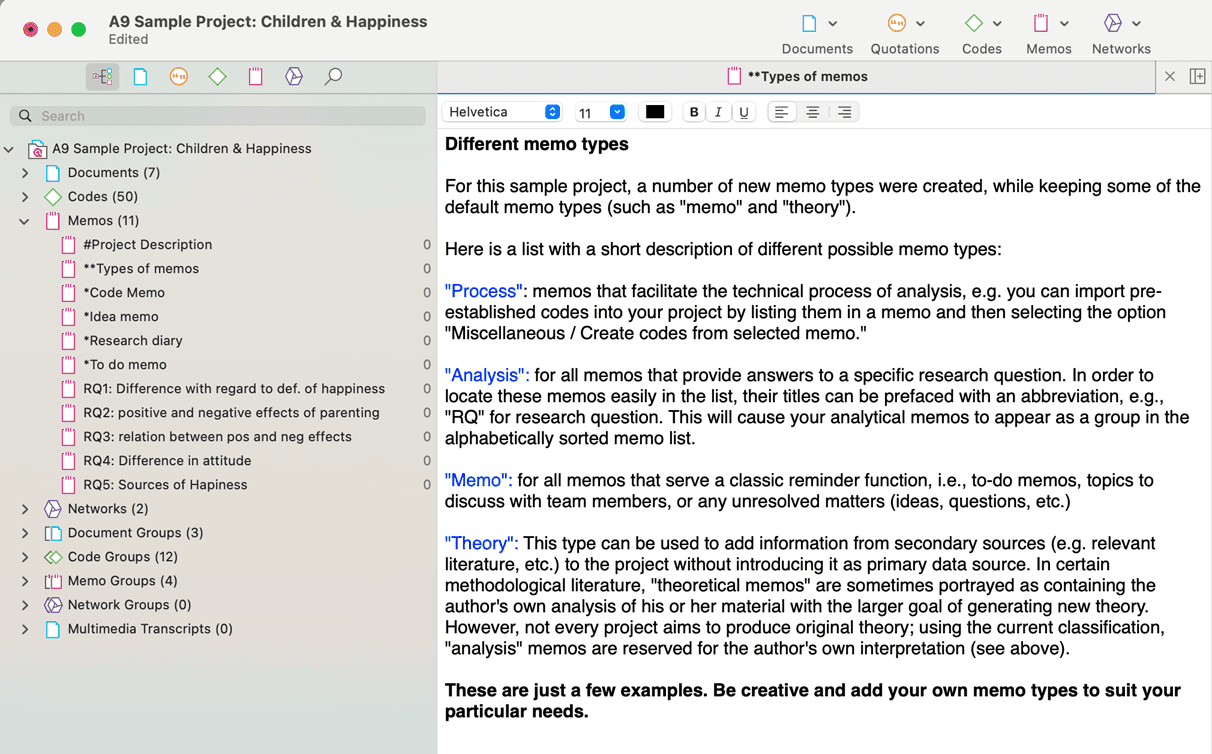
Typical Usage of Memos
-
Memos can contain a project description
-
You can list all research questions in a memo.
-
You can use memos to write a research diary.
-
You can use one memo as to do list.
-
Memos can be used as a bulletin board to exchange information between team members.
-
You can store definitions, findings or theories from relevant literature in one or more memos.
-
You can write up your analysis using memos. Those memos will be the building blocks for your research report.
Memos can also be assigned as documents, if you want to code them. See Using Memos as Document .
Differences between Memos and Comments
From a methodological point of view comments are also memos in the sense that comments are also places for thinking and writing.
In technical terms, in ATLAS.ti there is a distinction between comments and memos, as comments exclusively belong to one entity. For example, the document comment is part of the document; a code comment belongs to a particular code and is usually a definition for this code. A quotation comment contains notes or interpretations about the quotation it belongs to.
Comments are not displayed in browsers separately from the entity to which they are attached.
ATLAS.ti memos in comparison
- can be free-standing, or they can be linked to other entities.
- You can write a comment for a memo, for example: use this memo for section 2 in chapter 4 in my thesis.
Typical Usage of Comments
Below some ideas are listed for what you can use comments:
Project comment
- project description
Document comment
- Meta information about a document: source, where and how you found or generated it
- Interview protocols
Information about a respondent like gender, age, profession etc., are best handled by document groups. There is no need to write this type of information into the comment field.
Quotation Comment
- interpretations that only concern a specific data segment
- ideas how a quotation might be related to another quotation
- summaries for what you hear or see in the multimedia quotation
- interpretations of image quotations
- notes on a geo position
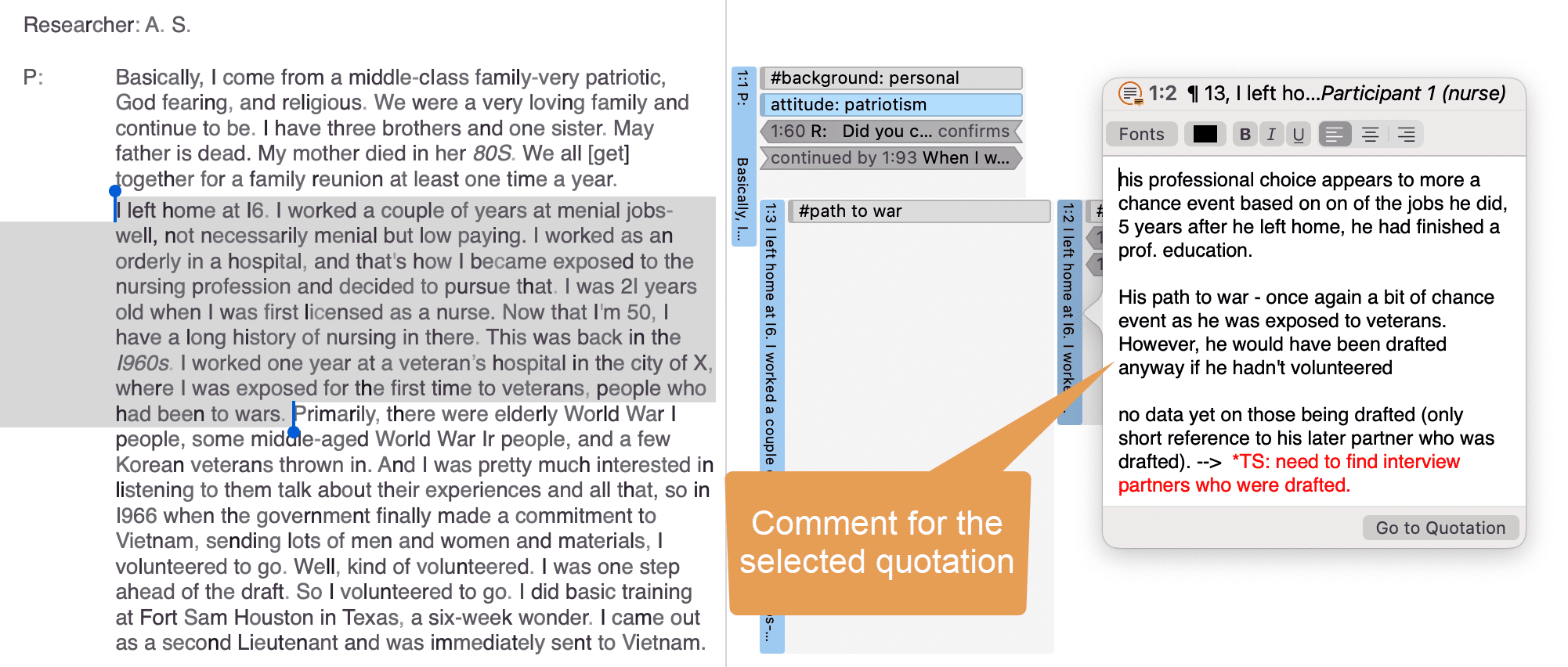
Code Comment
- first ideas what you mean by a code
- a code definition
- a coding rule, especially when working in a team
- an example of what kind of data can be coded with this code
- summary of coded segments

Memo Comment
- note to yourself where you want to use the memo in a report
- comments from supervisors or team members
- links to or notes about relevant literature
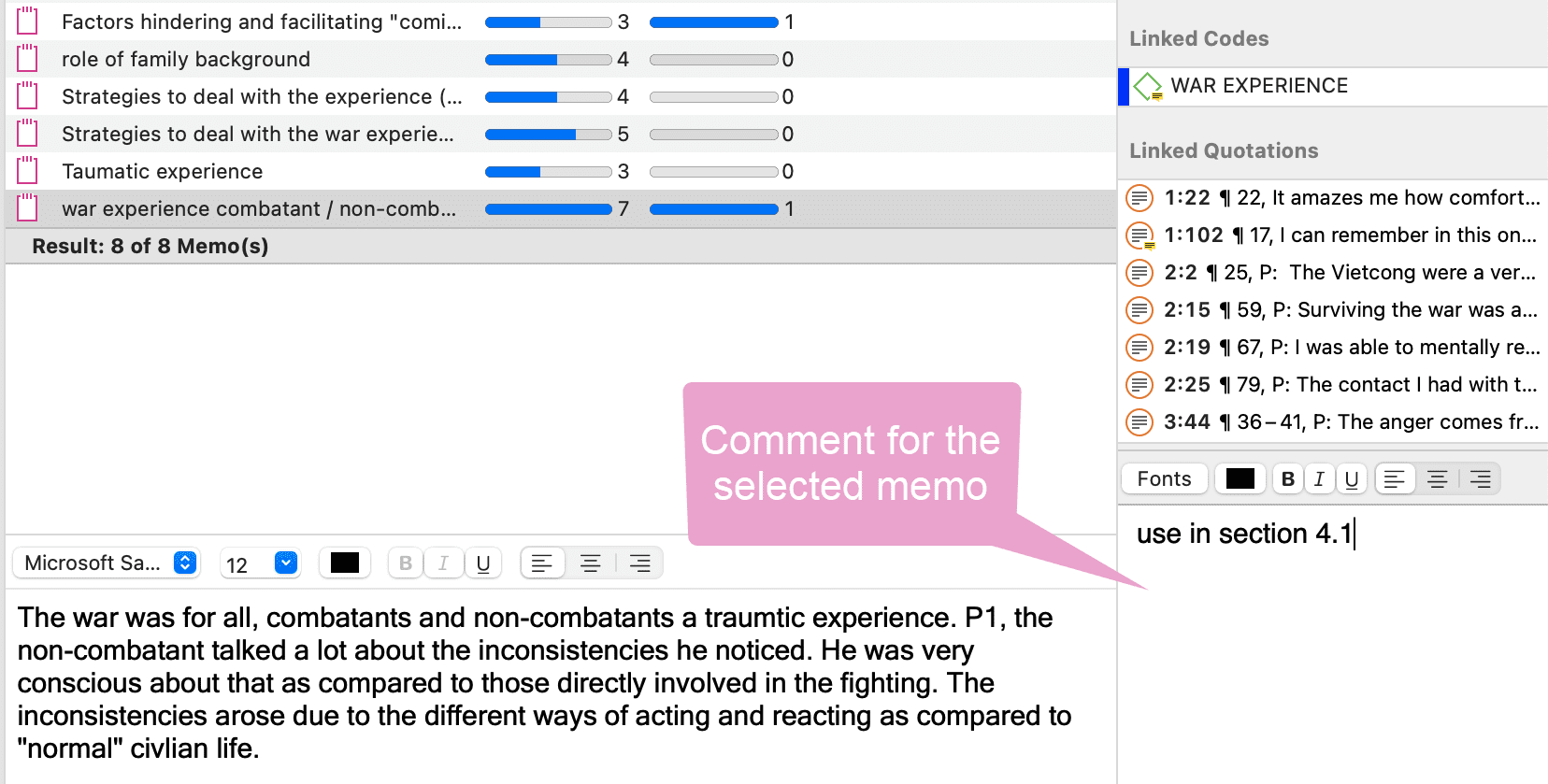
Network Comment
- description of the network
- idea how you want to develop it further
Link Comment
- Explaining why the two entities are linked in a specific way.
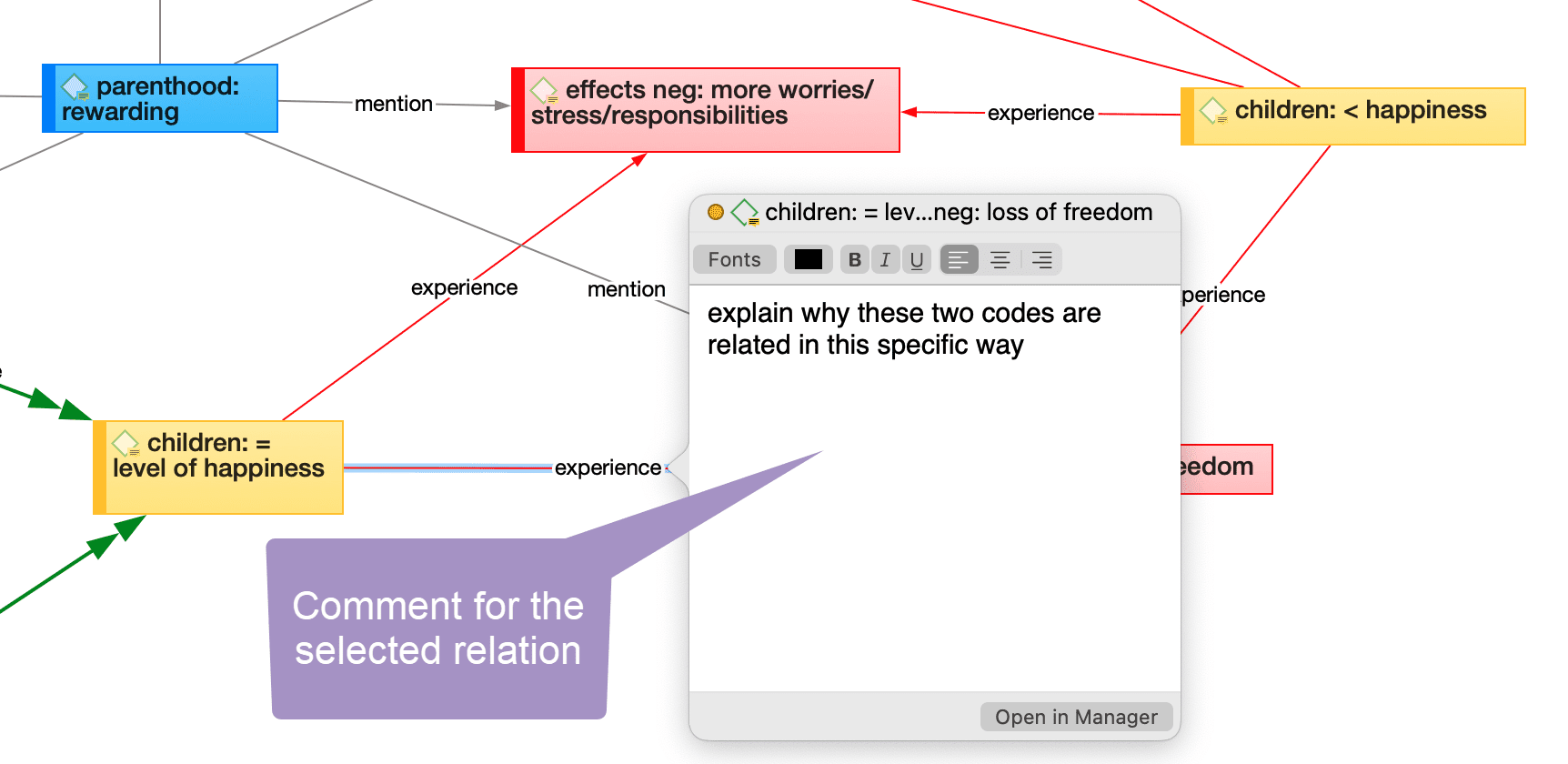
Writing a Comment
You find a field for writing comments in every Entity Manager.
To write a comment, select an item and type something in to the comment field in the inspector. Alternatively, you can right-click on any entity and select the Edit Comment option from the context menu. Both options are shown in the images. The comment is automatically saved.
All items that have a comment display a yellow post-it within their icon.
Creating Memos
Memos can be created from the toolbar, or in the Memo Manager.
To create a memo from the toolbar:
Click the drop-down menu for Memos and select New Memo. A new memo opens immediately, and you can change the default name in the inspector.
To create a memo in the Memo Manager
From the main menu select Memo > Show Memo Manager.
In the Memo Manager, click on the plus. A new memo is created in the list, and you can enter a title. You can begin to write your memo in the editor in the lower part of the Memo Manager.
Adding a Quotation to a Memo
You can copy and past quotations into a memo. This is for example useful if you want to include key quotes in your report.
Select a quotation, right-click and select Copy from the context menu, ir the short-cut cmd+c.
Paste the quotation in the memo editor, either using the short-cut cmd+v, or the context menu option. The quotation will be pasted into the memo including its reference, i.e., document name and location within in the document.
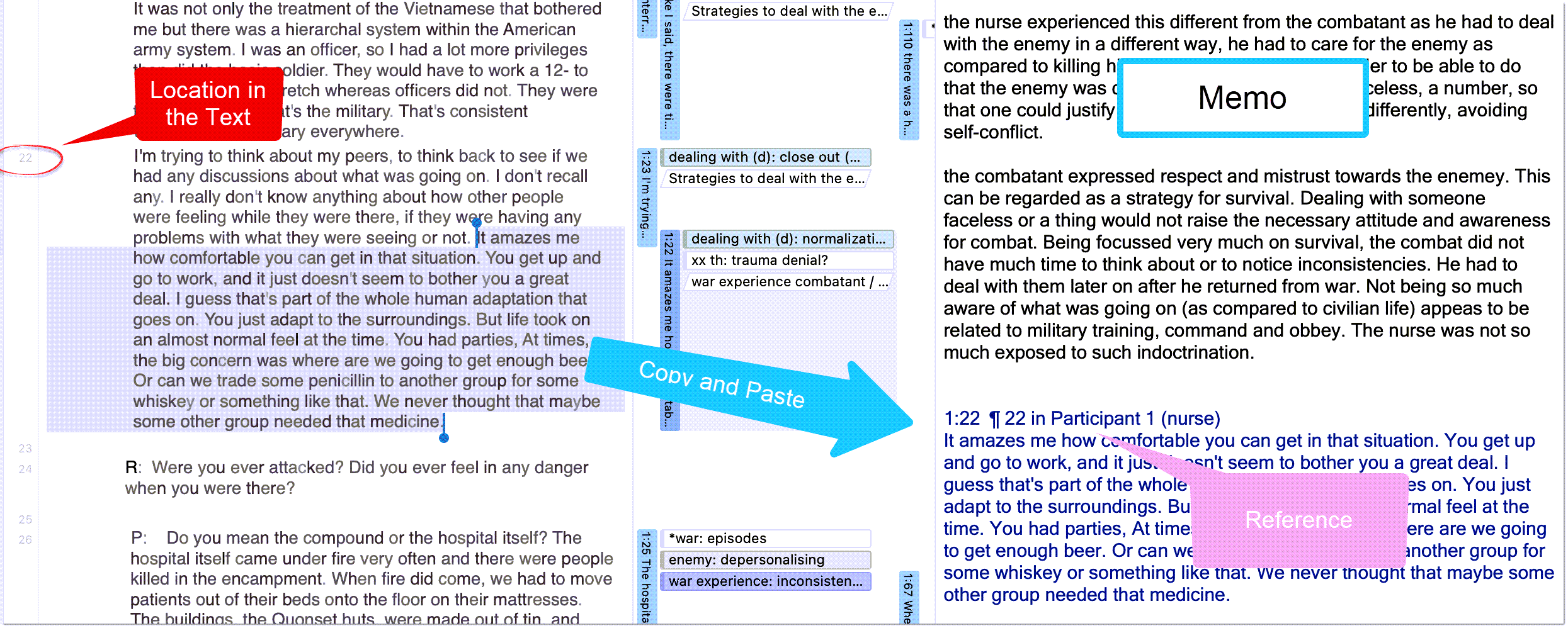
You can also copy and paste a quotation including its reference into any text editor, also outside of ATLAS.ti.
Opening an Existing Memo
You can access memos from everywhere: the Project Explorer, the Memo Manager, in the margin area if you linked a memo to a quotation, or from within a network.
If you want to review or continue to work on a memo, just double-click the memo. In the Memo Manager, you can select a memo with a single click and review and edit it in the lower part of the manager window.
Memos can be linked to quotations, codes and other memos. You can link memos per drag & drop basically anywhere in the program, or visually in networks. See Linking Nodes. Below a few examples are given.
References
Corbin, Juliet and Strauss, Anselm (2008). Basics of Qualitative Research: Techniques and Procedures for Developing Grounded Theory (3rd and 4th ed.). Thousand Oaks, CA: Sage.
Gibbs, Graham (2005). Writing as analysis. Online QDA.